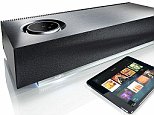From scooters to robo-helpers: Vespa maker Piaggio reveals Gita personal robot cargo carrier than can follow you home with your shopping
- Gita can carry up to 40lbs of goods and travel up to 22 mph
- Connects to sensors inside a belt worn by human operator
- Gita follows behind users and also maps out the environment
- It uses maps to autonomously travel through an area without operator
The firm that makes Vespa scooter has unveiled a new two-wheeled vehicle – but this model isn't designed to transport humans.
Made by the the Italian firm's Boston Fast Forward R&D lab, Gita is a robot cargo carrier capable of hauling up to 40 pounds (18 kg) of goods while following a human operator or moving autonomously through a mapped environment.
The blue ball-like machine stands about 26 inches (66 cm) tall and travels at bicycle speeds - up to 22 mph (35 km/h).
Scroll down for video
The firm that makes Vespa scooter unveiled a new two-wheeled vehicle. Called Gita, this robot cargo carrier capable of hauling up to 40lbs of goods while following a human operator or moving autonomously through a mapped environment
Instead of deciding to use an automobile or truck to transport to lug packages and other goods , Piaggio Fast Forward wants to help people walk, run, pedal and skate through life with the assistance of a family of vehicles like Gita.
The firm describes Gita as 'an intelligent and nimble cargo vehicle designed and engineered with the same attention to safety, braking, balancing and vehicle dynamics that you would expect of a high-performance motorcycle.'
Gita, pronounced 'jee-ta', which means 'short trip in Italian', is an intelligent vehicle with a communicative personality – making it the perfect travel buddy.
'The transportation and robotics industries tend to focus on optimizing tasks and displacing labor,' according to Jeffrey Schnapp, CEO of Piaggio Fast Forward.
'We are developing products that augment and extend human capabilities, instead of simply seeking to replace them.'
The robot is designed to learn and navigate using both oversight and decision-making of humans.
Users simply unlock the top lid and place anything from groceries to laundry inside of the machine.
It links to a unique white belt that is equip with a camera on the front and uses technology known as Simultaneous Localization and Mapping (SLAM), which creates a 3D point cloud map while the human operator walks, reports New Atlas.
Users simply unlock the top lid and place anything from groceries to laundry inside of the machine. This method makes it easier to lug goods around without having to use a car or truck
And the robot is designed to recognize its owner as it moves through the map using the front-face camera attached to the belt.
Once it has traveled through the environment, it is able refer back to that specific map - allowing it to take the journey autonomously.
'Think about how much more freely you would be able to move from one point to another if lugging cumbersome items was removed from the equation,' added Schnapp.
'Gita frees up the human hand to focus on complex and creative everyday tasks by taking over mundane transportation chores.'
It links to a unique white belt that is equip with a camera on the front and uses technology known as Simultaneous Localization and Mapping (SLAM), which creates a 3D point cloud map while the human operator walks
The robot is designed to recognize its owner as it moves through the map using the front-face camera attached to the belt. Once it has traveled through the environment, it is able refer back to that specific map - allowing it to take the journey autonomously
'You can also send your Gita off on missions while you are busy doing something more pressing.'
Users can also establish waypoints in the map, which Gita will stop at while it travels on its own and uses cameras and an ultrasonic range-finding system to 'see' and avoid obstacles in its way.
Users can also establish waypoints in the map, which Gita will stop at while it travels on its own and uses cameras and an ultrasonic range-finding system to 'see' and avoid obstacles in its way. And with just a three hour charge, the robot can roll around for eight hours at walking speed
And with just a three hour charge, the robot can roll around for eight hours at walking speed.
The robot is also designed to park itself when not in use
Gita is set to launch on February 2nd in Boston, Massachusetts, but the firm has yet to reveal the pricing.
There is also no mention when the cargo carrying robot will be available to the public, but Piaggio Fast Forward said it will conduct pilot tests with businesses this year.
Vespa is better known for its iconic scooters. Here, a woman walks past a row of repaired old scooters displayed for sale along a street in Ho Chi Minh, Vietnam
Most watched News videos
- Muslim American woman films man as he bullies her at cafe
- Terrified wedding guests shot at by lone gunman during ceremony
- 'My mum's a witch!': 'Drugged' Mischa Barton's scary breakdown
- Heroic dogs save terrified woman from deadly King Cobra snake
- Winona Ryder looks confused during David Harbour's speech at SAGs
- Terrifying moment tiger attacks man inside zoo enclosure in China
- Incredible moment mother KICKS her toddler daughter to safety
- Parcelforce driver crashes into parked car and drives off
- Beauty queen steals show with dance moves at Miss Universe
- Loose Women: Farage rows with Saira Khan over US travel ban
- Hong Kong housing crisis causes residents to live in coffin homes
- Piranhas munch away on bulls head ripping it to shreds
-
 Islamic State's chief executioner - who has beheaded more...
Islamic State's chief executioner - who has beheaded more... -
 'You're fired!' Trump sacks Obama-appointed acting...
'You're fired!' Trump sacks Obama-appointed acting... -
 Brave hijab-wearing Muslim-American woman films the...
Brave hijab-wearing Muslim-American woman films the... -
 PICTURED: White university student named as the sole...
PICTURED: White university student named as the sole... -
 Supreme Court nomination will come TOMORROW as Trump...
Supreme Court nomination will come TOMORROW as Trump... -
 Trump's first combat casualties: Eight-year-old American...
Trump's first combat casualties: Eight-year-old American... -
 The wedding assassin: Would-be killer follows bride and...
The wedding assassin: Would-be killer follows bride and... -
 Protestors take to Britain's streets over Trump's state...
Protestors take to Britain's streets over Trump's state... -
 'Oh you f****** witch': Disturbing footage shows Mischa...
'Oh you f****** witch': Disturbing footage shows Mischa... -
 'Shoot Harry just to frighten him - shut him up':...
'Shoot Harry just to frighten him - shut him up':... -
 The beach where nature has transformed a Russian dumping...
The beach where nature has transformed a Russian dumping... -
 Loner student 'who liked Trump, Le Pen and mocked Syrian...
Loner student 'who liked Trump, Le Pen and mocked Syrian...













 Your comment will be credited to your MailOnline persona
Your comment will be credited to your MailOnline persona














































































































































































































































































 'Best part of 2017!' Social media users go gaga over hilarious video of Winnie the Pooh performing Gangnam Style dance - and quickly turn it into a viral meme with different backing tracks
'Best part of 2017!' Social media users go gaga over hilarious video of Winnie the Pooh performing Gangnam Style dance - and quickly turn it into a viral meme with different backing tracks